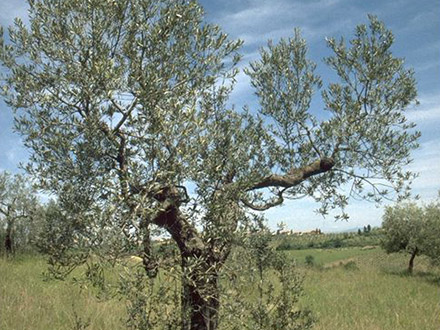Botanical name
Olea europaea L.
Family
Oleaceae
Common name
African olive, European olive, Common olive.
Information about the plant
The olive tree is an ancient cultural and characteristic plant of the Mediterranean region, originating from the wild Mediterranean variety Olea europaea var. sylvestris<. Its cultivation dates back many millennia and probably began in the Eastern Mediterranean region. Around 300 different olive varieties are cultivated worldwide to produce table olives and olive oil. These products form an important industry in Mediterranean countries, particularly Spain, Italy, and Greece.
The olive tree is resilient, requiring little in terms of soil and climate and can live for hundreds of years. It can also be used throughout its entire life. Its leaves are narrow, grey-green on the upper surface, silvery-white underneath, and arranged oppositely on the branches. After the second year, they fall off. The yellowish-white flowers grow like panicles on short axillary shoots; they bloom in June, and the olives ripen between October and December. They are single-seeded drupes and, depending on the variety, are green or blue-black, like a small plum. Each tree can yield 60 to 65kg of olives per year.
Since early European history, the olive tree has held high symbolic value. Its branches were considered a sign of peace, and in the early Olympic Games, victors were crowned with wreaths made of olive leaves.
Medicinally used parts of plants (herbal drug)
The dried leaves (Oleae folii) and the oil from the fruit (Olivae oleum) are used. The leaves are mainly imported from Spain, while olive oil is imported from other European and North African Mediterranean countries.
Constituents of the herbal drug
Olive leaves contain esterified phenolic secoiridoids, mainly oleuropein, a glycosidically bound ester of elenolic acid with hydroxytyrosol; they also contain free tyrosol, hydroxytyrosol, and flavonoids. When olive tree leaves are dried and processed, oleuropein undergoes ring opening to form oleacein. Oleic acid is the most abundant fatty acid in olive oil (56-86% after saponification).
Quality of the drug
The quality of the following drugs or drug preparations is specified in the European Pharmacopoeia (Ph. Eur.):
- Olive tree leaves (Olea folium)
- Olive tree leaves extract (Oleae folii extractum siccum)
- Extra virgin olive oil (Olivae oleum virginal)
- Refined olive oil (Olivae oleum raffinatum)
Medical applications
Recognised medical use
The HMPC has classified olive leaves as a traditional herbal medicinal product (see ‘Traditional use’).
ESCOP: Olive leaves have not been evaluated.
Olive leaves are used in folk medicine to treat high blood pressure, gout, arteriosclerosis, and rheumatism. The hypotensive properties are attributed to oleuropein in the leaves and the oleacein formed when dried. Animal studies with olive leaf extracts and isolated iridoids have confirmed hypotensive effects; however, no clinical studies are available, which is why the effectiveness has not yet been proven. See also ‘Traditional use’.
Olive oil is used pharmaceutically as an extractant for the production of oil resins (e.g. cayenne pepper oil resin) and, in purified form, to produce parenteral preparations (injections).
Traditional use
Olive leaves have been classified by the HMPC as a traditional herbal medicinal product (Article 16a of Directive 2001/83/EC). Based upon long-standing use, olive leaves can be used to stimulate renal water excretion (diuresis) in cases of mild urinary retention.
Registration as a traditional medicinal product: Traditionally used to support cardiovascular function.
Herbal drug preparations in finished dosage forms
- Cut drug to prepare tea
- Powdered olive leaves in coated tablets
- Dried extract in tablets
Dosage
Prepared drugs: See patient information leaflet.
Tea: Drink 1 cup of olive leaf tea 3 to 4 times a day.
Preparation of a tea
Pour 150 mL of boiling water over 2 to 5 g of finely cut leaves and strain after 30 minutes.
Notes
Olive leaves should not be taken in cases of severe heart or kidney disease.
No studies are available on the use of olive tree leaves during pregnancy and lactation. The use in children and adolescents under 18 years of age is not recommended due to a lack of evidence.
Side effects
Possible allergic reactions.
Interactions
None known.
References
Herbal drug monographs
HMPC (2018)
Further literature
Commentary on the European Pharmacopoeia (Olive leaves, No. 1878; Dry extract of olive leaves, No. 2313; Virgin olive oil, No. 0518; Refined olive oil, No. 1456)


